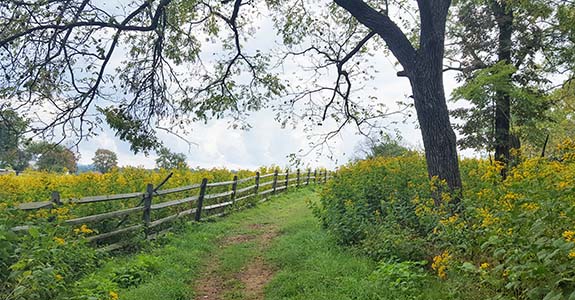
 Department of Conservation and Recreation
Department of Conservation and Recreation
Conserve. Protect. Enjoy.
 Department of Conservation and Recreation
Department of Conservation and Recreation

National trails are officially established under the authorities of the National Trails System Act (16 USC 1241-51). There are several types:
The Appalachian Trail is unique because of its history of cooperative management. One-quarter of the entire trail, 550 miles, runs through Virginia. For more than 75 years, the many representatives of the Appalachian Trail Conservancy (ATC) have worked voluntarily with federal, state and local governments, as well as numerous individual landowners, to solve problems associated with the acquisition, development, administration, management and maintenance of the trail. The Appalachian Trail Conservancy and its member clubs manage the trail. Recognizing its importance, the Virginia General Assembly in the Code of Virginia, Chapter 10.1-203, as amended, designated DCR as responsible for acquisition, administration and management of the trail in Virginia.
As one of the state's trunkline trail systems under development, the PHNST also has a unique status in Virginia. DCR has entered into a cooperative agreement with the National Park Service to assist with trail development.
Most of Virginia's existing long-distance hiking, horseback riding, and public off-road motorized trails are on federal lands. The George Washington and Jefferson National Forests contain 2,385 miles of system trails, including 375 miles of the Appalachian Trail. Most of the trails are non-motorized and multi-use, allowing hikers, equestrians and mountain bikers. The forests also have 78 miles of motorized trails open to unlicensed motorized vehicles (ATVs and trail bikes). Shenandoah National Park contains 516 miles of trails, including 101 miles of the Appalachian Trail and approximately 200 miles of horse trails. Together, these two resources provide 2,901 miles of backcountry trails.
In Eastern Virginia, Assateague Island National Seashore, the Great Dismal Swamp National Wildlife Refuge, Back Bay National Wildlife Refuge, Prince William Forest Park and the larger national battlefields all offer opportunities for trail users (Petersburg, Richmond, Manassas, Fredericksburg)
Virginia is host to the first two officially designated U.S. Bike Routes, established in 1982 by the American Association of State Highway and Transportation Officials. U.S. Bike Route 76, also known as the Transamerica Route, runs west to east and U.S. Bike Route 1 runs north to south. Combined they comprise more than 838 miles in Virginia. Adventure Cycling is the lead organization working to create an official U.S. cycling route network, the U.S. Bicycle Route System.

